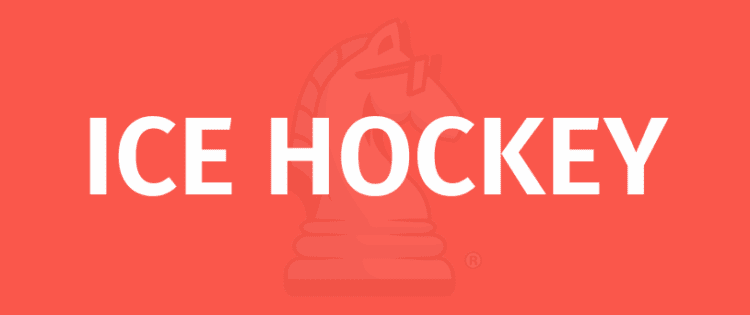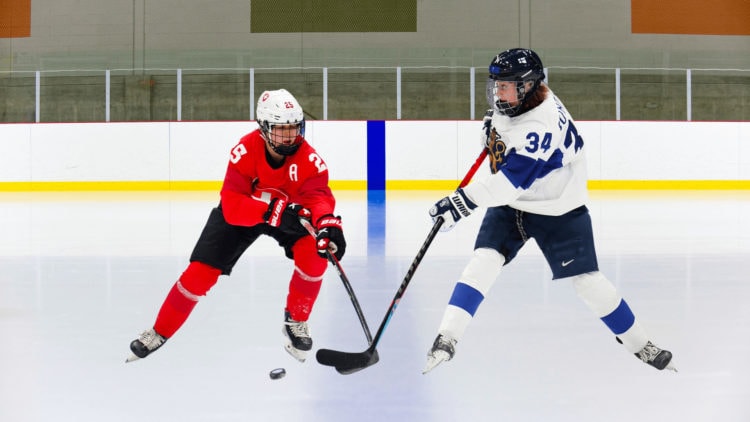
OBJECTIVE OF ICE HOCKEY: Score more goals than the opposing team by shooting the puck through the goal using an ice hockey stick.
NUMBER OF PLAYERS: 12 players, 6 on each team
MATERIALS: 1 ice hockey stick per player, padding, helmets, ice hockey goals, ice hockey puck, 1 pair of ice skates per player
TYPE OF GAME: Sport
AUDIENCE: 7+
OVERVIEW OF ICE HOCKEY
Ice hockey is a fast-paced, exciting sport requiring a lot of skill. Players must have impeccable balance, hand-eye coordination, and mobility. Hockey is played on ice, so players are not only skating around the ice but also trying to control a small black hockey puck.
The sport is especially popular in the northern states of the USA and Canada, but even warm southern states like Texas have teams competing in the NHL. Hockey is a team sport where five players attempt to make the puck go into the other team’s goal, which is guarded by a goalie.
SETUP

RINK
Ice hockey is played on an ice rink that is 200 feet long and 85 feet wide. The center of the rink is split by the center line. The face-off spot lies directly in the center of the rink. Adjacent to the center face-off spot are four small dots that mark other face-off spots.
Two blue lines are 25 feet away from the center line on each side of the court. These lines are used to determine whether a player is offsides or not.
There are two circles on each side of the court that are also face-off spots where two players will compete for possession of the puck.
The goal lines mark the boundary on each side of the court, with the goals sitting in the center. Behind the goal is a trapezoid-shaped area where the goalie can freely move and control the puck with their stick.
There is also a small arc around each goal called the goal crease.
PLAYERS
There are three main positions in hockey.
FORWARD: There are generally three forwards responsible for most offensive plays. They rush the goal and attempt to score goals when they have possession of the puck and defend when the opposing team has possession. The center forward is the forward that starts in the center of the rink and will generally take the face-offs.
DEFENSE: The defenders are responsible for preventing the puck from reaching the goalie. Although they can participate in offensive plays, they rarely attempt to score goals and generally stick to the defensive side of the rink.
GOALIE: The goalie is a hockey team’s last line of defense. They generally stay directly in front of the net for the entire game and block goal attempts from the opposing team.
GAMEPLAY

Hockey games are played in three 20-minute periods. There is a short break called an intermission between these periods.
FACE-OFF
The face-off determines which hockey team starts with the puck during each period. Face-offs are also used to start plays after a goal is scored or any other stoppage of play.
The referee determines which of the nine face-off spots to use. The face-off always occurs in the center face-off circle at the beginning of each period and after a goal is scored.
Two players from each team will be selected to compete for possession of the puck. They must both remain inside the face-off zone until the puck drops. Once the puck drops, they will attempt to gain possession of it, dribble it down the rink, and pass it to a teammate.
SCORING
A goal is scored in ice hockey when the puck passes within the goal and behind the goal line. Any player can technically score a goal in hockey even if they accidentally score a goal against their own team. Each goal is worth one point.
Players cannot kick or throw the puck across the goal line.
ICING
Icing occurs when a hockey team player hits the puck from their side of the center line to the goal line without another team member or a member of the opposing team touching the puck.
The result of icing the puck is a face-off on the player’s defending side of the rink.
OFFSIDES
In ice hockey, players are not allowed to cross the blue line and enter the offensive side of the rink until the puck has crossed to that side. If a player is caught on the offensive side of the rink before the puck enters, they will be called offsides. The result of offsides is a face-off.
PENALTY SHOTS
A penalty shot is awarded to a player who controls the puck and is fouled by a defender. During a penalty shot, the offensive player is given a free shot at the goal, and no other player is allowed to interfere besides the opposing team’s goalie.
Here are some penalties that result in a penalty shot:
- Hitting from behind
- Fighting
- Elbowing
- Trip
- Cross-checking (hitting a player with a hockey stick)
The penalty shot is taken from the point on the rink where the player was fouled. All players besides the goalie and the fouled player must leave the rink until after the penalty shot. The goalie must also remain inside the goal crease until the player has hit the puck.
FIGHTING
One of the most thrilling (and gruesome) parts of hockey is the fighting. Professional hockey is the only major sport that allows fighting (other than fighting sports, of course). The rules for fighting in ice hockey are not exactly clear. In the NHL, fighting is allowed but still against the rules. This means that referees will not break up a fight when one breaks out between two players, but these players will still receive penalties for participating in a fight.
If two players drop their gloves and square up to fight, the referee blows their whistle, and all other players must leave the ice. The players participating must not remove their helmets and must stop the fight when one player concedes, the referee breaks up the fight, or a player hits the ice. Both players will receive penalties, and a player who instigates the fight or is excessively aggressive will receive extra penalties.
END OF GAME
A hockey game ends after the third period. The team with the highest score at this point wins the game. If the game is tied at the end of the third period, the teams will play an extra 10-minute period. If the game is tied at the end of the extra period, a shootout will determine the winner.
A shootout is a tie-breaker in which three players from each team will take turns shooting goals one-on-one with the goalie. This continues until one team has scored more goals in the shootout than the other.
- Comprehensive Guide to the Board Game Go (weiqi, baduk) - January 23, 2024
- Are Creative Suites Changing Gaming - October 30, 2023
- Crowning the Kings of Solitaire: GameRules Recognizes Solitaired and MobilityWare as top Solitaire Games - October 20, 2023